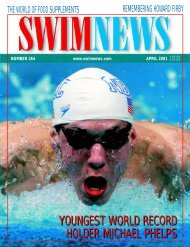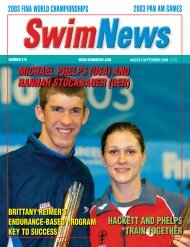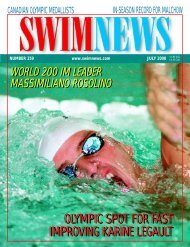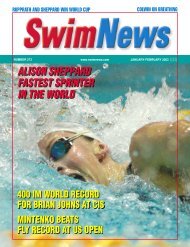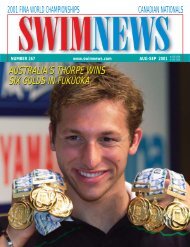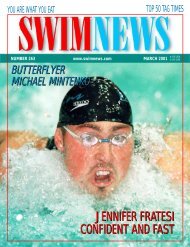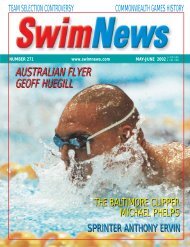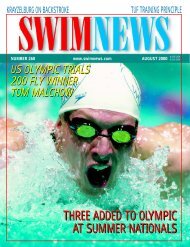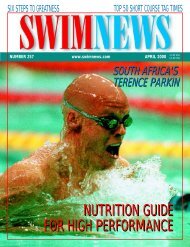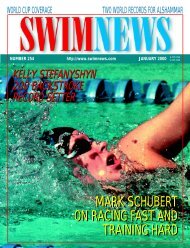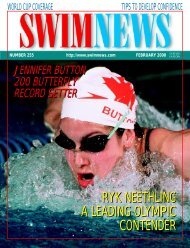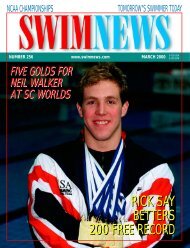EUROPEAN JUNIOR CHAMPIONSHIPSLinz, AUT, <strong>Jul</strong> 11-14 (50 M)BOYS born 1984-8550 METRES FREESTYLE1 22.74 Cavic Milorad,84,YUG2 23.06 Tilly Jonas,84,SWE3 23.33 Rajakyla Matti,84,FIN4 23.36 Mallet Gregory,84,FRA5 23.36 Puninski Alex,85,SLO6 23.54 Kuhn David,84,GER7 23.59 Zatsepin Alexei,84,RUS8 23.64 Veliaca Ivan,84,CRO100 METRES FREESTYLE1 50.47 Gilot Fabien,84,FRA2 50.49 Cavic Milorad,84,YUG3 50.84 Viktoravicius Paulius,84,LTU4 51.48 Salabutau Yahor,84,BLR5 51.53 Galavtine Antoine,85,FRA6 51.59 Koll Dominik,84,AUT7 51.60 Delac Mario,85,CRO8 1:01.15 Savino Andrea,84,ITA200 METRES FREESTYLE1 1:50.26 Prilukov Yuri,84,RUS2 1:52.27 Natsvin Evgeni,85,RUS3 1:52.36 Gilot Fabien,84,FRA4 1:52.61 Carneiro Ivo,84,POR5 1:52.83 Koll Dominik,84,AUT6 1:53.36 Webster Paul,84,GBR7 1:53.45 Savino Andrea,84,ITA8 1:53.47 Gegotek Piotr,84,POL400 METRES FREESTYLE1 3:53.59 Prilukov Yuri,84,RUS2 3:54.83 Davies David,80,GBR3 3:56.54 Natsvin Evgeni,85,RUS4 3:57.27 Diamantidis Georgios,84,GRE5 3:57.98 Stanczyk Przemyslaw,85,POL6 3:58.26 Carneiro Ivo,84,POR7 4:00.42 Kvale Gard,84,NOR8 4:00.42 Livnat Shay,84,ISR1500 METRES FREESTYLE1 15:14.85 Prilukov Yuri,84,RUS2 15:36.49 Korzeniowski Pawel,85,POL3 15:36.51 della Valle Simone,84,ITA4 15:44.86 Kvale Gard,84,NOR5 15:45.10 Herbert Thomas,85,GBR6 15:52.63 Zdesar Bojan,84,SLO7 15:53.89 Natsvin Evgeni,85,RUS8 15:54.14 Diamantidis Georgios,84,GRE50 METRES BACKSTROKE1 26.64 Viatchanin Arkadi,84,RUS2 26.65 Mantymaki Manu,85,FIN3 26.73 Keil Dominik,85,GER4 27.22 Ruscio Andrea,84,ITA5 27.33 Tardin Alain,84,SUI6 27.38 Grigoriadis Aristidis,85,GRE7 27.51 di Carli Marco,85,GER8 DQ Rudolf Roland,85,HUN100 METRES BACKSTROKE1 56.09 Keil Dominik,85,GER2 56.91 Viatchanin Arkadi,84,RUS3 57.18 Mantymaki Manu,85,FIN4 57.53 Rudolf Roland,85,HUN5 58.38 Ruscio Andrea,84,ITA6 58.51 Betlej Wojciech,84,POL7 58.81 Keetman John,84,NED8 59.65 Massacand Jonathan,84,SUI200 METRES BACKSTROKE1 2:02.81 Viatchanin Arkadi,84,RUS2 2:03.42 Hughes Ross,84,GBR3 2:04.61 Meeuw Helge,84,GER4 2:05.16 Zdesar Bojan,84,SLO5 2:05.88 Rudolf Roland,85,HUN6 2:06.70 Keil Dominik,85,GER7 2:07.67 Betlej Wojciech,84,POL8 2:09.11 Keetman John,84,NED50 METRES BREASTSTROKE1 29.11 Terrin Alessandro,85,ITA2 29.24 Nielsen Joakim,84,SWE3 29.28 Cool Philipp,84,GER4 29.33 Thiallet Anthony,85,FRA5 29.36 Ramos Bruno,84,POR6 29.39 Swiers Jago,84,BEL7 29.57 Sigurdsson Jon,84,ISL8 29.78 Financsek Gabor,85,HUN100 METRES BREASTSTROKE1 1:03.25 Cool Philipp,84,GER2 1:03.73 Nielsen Joakim,84,SWE3 1:04.13 Borisik Igor,84,UKR4 1:04.18 Swiers Jago,84,BEL5 1:04.37 Neiva Henrique,84,POR6 1:04.56 Sommaripa Marco,84,ITA7 1:04.91 Pernat Matiaz,84,SLO8 1:05.32 Agache Dragos,84,ROM200 METRES BREASTSTROKE1 2:17.08 Boral Lukasz,84,POL2 2:17.82 Bossini Paolo,85,ITA3 2:18.32 Neiva Henrique,84,POR4 2:18.81 Neumann Johannes,85,GER5 2:19.05 Grigoryev Andrei,84,RUS6 2:19.72 Pernat Matiaz,84,SLO7 2:19.86 Plutecki Adam,85,POL8 2:20.73 Borisik Igor,84,UKR50 METRES BUTTERFLY1 24.57 Puninski Alex,85,CRO2 24.67 Skvortsov Nikolai,84,RUS3 24.67 Sundin Tor,84,SWE4 24.70 Cavic Milorad,84,YUG5 24.77 Dietrich Johannes,85,GER6 24.86 Advena Sergiy,84,UKR7 24.90 Leveau Amaury,85,UKR8 25.11 Goldin Rudy,84,ITA100 METRES BUTTERFLY1 53.76 Advena Sergiy,84,UKR2 54.08 Cavic Milorad,84,YUG3 54.15 Skvortsov Nikolai,84,RUS4 54.27 Dietrich Johannes,85,GER5 54.82 Salcius Rimvydas,85,LTU6 55.02 Goldin Rudy,84,ITA7 55.29 Meeuw Helge,84,GER8 55.64 Drzewinski Lukasz,84,POL200 METRES BUTTERFLY1 1:59.25 Drymonakos Ioannis,84,GRE2 2:00.21 Drzewinski Lukasz,84,POL3 2:00.25 Advena Sergiy,84,UKR4 2:00.28 Skvortsov Nikolai,84,RUS5 2:01.15 Korzeniowski Pawel,85,POL6 2:02.00 Dietrich Johannes,85,GER7 2:02.30 Kiss Boldizsar,85,HUN8 2:02.42 Mourao Duarte,84,POR200 METRES IND.MEDLEY1 2:03.65 Berezutsky Igor,84,RUS2 2:04.92 Zatsepin Alexei,84,RUS3 2:05.35 Savino Andrea,84,ITA4 2:05.57 Alexandrov Mihail,85,BUL5 2:06.05 van Aggele Robin,84,NED6 2:06.13 Andrijauskas Paulius,84,LTU7 2:06.24 Cseh Laszlo,85,HUN8 2:07.37 Zoldak Kryzsztof,84,POL400 METRES IND.MEDLEY1 4:19.81 Berezutsky Igor,84,RUS2 4:20.24 Cseh Laszlo,85,HUN3 4:25.75 Zoldak Kryzsztof,84,POL4 4:26.55 Drymonakos Ioannis,84,GRE5 4:26.60 Zatsepin Alexei,84,RUS6 4:27.96 Korzeniowski Pawel,85,POL7 4:28.15 Alexandrov Mihail,85,BUL8 4:32.10 Hughes Ross,84,GBR4X100 MEDLEY RELAY1 3:44.99 Germany,GER2 3:47.49 Russia,RUS3 3:48.31 Hungary,HUN4 3:50.01 France,FRA5 3:51.14 Ukraine,UKR6 3:51.33 Belgium,BEL7 DQ Israel,ISR8 DQ Sweden,SWE4X100 FREE RELAY1 3:24.12 France,FRA2 3:26.30 Germany,GER3 3:26.91 Sweden,SWE4 3:28.37 Croatia,CRO5 3:29.42 Ukraine,UKR6 3:29.57 Finland,FIN7 3:30.01 Italy,ITA8 3:30.80 Portugal,POR4X200 FREE RELAY1 7:28.25 Russia,RUS2 7:30.16 France,FRA3 7:32.69 Great Britain,GBR4 7:36.48 Germany,GER5 7:39.23 Portugal,POR6 7:40.41 Poland,POL7 7:44.82 Spain,ESP8 7:46.05 Israel,ISRGIRLS born 1986-8750 METRES FREESTYLE1 25.76 Gotz Daniela,87,GER2 25.86 Korc Agata,86,POL3 26.26 Hofmann Nele,86,GER4 26.56 Barzycka Paulina,86,POL5 26.74 Heemskerk Femke,87,NED6 26.74 Pinto Delfina,87,ITA7 26.75 Klosova Petra,86,CZE8 27.14 Florio Silvia,86,ITA100 METRES FREESTYLE1 56.73 Hofmann Nele,86,GER2 56.92 Sych Regina,87,RUS3 57.16 Korc Agata,86,POL4 57.17 Gotz Daniela,87,GER5 57.21 Barzycka Paulina,86,POL6 57.47 Jovanovic Sanja,86,CRO7 57.61 Zoccari Flavia,86,ITA8 58.34 Mylosi Dominiki,86,GRE200 METRES FREESTYLE1 2:02.40 Shornikova Polina,86,RUS2 2:03.55 Sych Regina,87,RUS3 2:04.17 Pagliarini Silva,86,ITA4 2:04.39 Lipcsei Krisztina,86,HUN5 2:04.42 Hantke Stephanie,87,GER6 2:05.37 Tsagka Evagelia,87,GRE7 2:05.93 Caleca Renata,86,ITA8 2:06.04 Wyld Ka<strong>the</strong>rine,86,GBR400 METRES FREESTYLE1 4:15.43 Sych Regina,87,RUS2 4:15.58 Shornikova Polina,86,RUS3 4:19.25 Lipcsei Krisztina,86,HUN4 4:21.01 Suttora Marina,86,ITARATING SUMMARY OF TOP PERFORMANCES1) 978 2:26.42 200 breast W Mirna Jukic,AUT2) 965 2:11.56 200 back W Stanislava Komarova,RUS3) 964 1:01.88 100 back W Laure Manaudou,FRA4) 964 4:19.81 400 IM M Igor Berezutsky,RUS5) 961 15:14.85 1500 free M Yuri Prilukov,RUS6) 961 4:20.24 400 IM M Laszlo Cseh,HUN7) 958 53.76 100 fly M Sergiy Advena,UKR8) 952 1:59.25 200 fly M Ioannis Drymonakos,GRE9) 950 56.09 100 back M Dominik Keil,GER10) 949 54.08 100 fly M Milorad Cavic,YUG5 4:23.24 Assnousi Fadma,86,ESP6 4:23.43 Strouba Olga,87,GRE7 4:23.57 Ferreira Marta,86,POR8 4:24.41 Nagy Reka,86,HUN800 METRES FREESTYLE1 8:43.64 Tolkacheva Yana,87,RUS2 8:43.71 Nagy Reka,86,HUN3 8:44.47 Payne Kerianne,87,GBR4 8:52.30 Rutili Giulia,87,ITA5 8:53.49 Strouba Olga,87,GRE6 8:58.59 Hantke Stephanie,87,GER7 8:58.66 Suttora Marina,86,ITA8 8:58.86 Margioukla Theodora,86,GRE50 METRES BACKSTROKE1 29.34 Komarova Stanislava,86,RUS2 29.45 Manaudou Laure,86,FRA3 29.68 Jovanovic Sanja,86,CRO4 29.81 Amshennikova Irina,86,UKR5 30.04 Baum <strong>Jul</strong>ia,86,GER6 30.04 van Schaik Lenneke,86,NED7 30.10 Szabo-Szepesi Nikolett,87,HUN8 30.61 Moonan Susannah,87,SWE100 METRES BACKSTROKE1 1:01.88 Manaudou Laure,86,FRA2 1:02.35 Komarova Stanislava,86,RUS3 1:03.12 Amshennikova Irina,86,UKR4 1:03.79 Jovanovic Sanja,86,CRO5 1:03.79 Szabo-Szepesi Nikolett,87,HUN6 1:03.88 Putra Alexandra,86,FRA7 1:04.40 Baum <strong>Jul</strong>ia,86,GER8 1:05.39 van Schaik Lenneke,86,NED200 METRES BACKSTROKE1 2:11.56 Komarova Stanislava,86,RUS2 2:14.29 Amshennikova Irina,86,UKR3 2:17.81 Backhaus Stephanie,84,GER4 2:18.11 Palmai Andrea,86,HUN5 2:19.82 Baron Es<strong>the</strong>r,87,FRA6 2:20.37 Loparyova Ekaterina,86,RUS7 2:20.50 Jovanovic Sanja,86,CRO8 2:20.62 Mayer Kerstin,86,AUT50 METRES BREASTSTROKE1 32.54 Haywood Kate,87,GBR2 32.62 Sambrailo Tamara,86,SLO3 32.64 Chocova Petra,86,CZE4 32.66 Tour Katarina,87,SWE5 32.73 Jukic Mirna,86,AUT6 32.82 Dizdarevic Sanja,87,SWE7 33.32 Steinmetz Franziska,86,GER8 33.72 Boggiatto Chiara,86,ITA100 METRES BREASTSTROKE1 1:09.91 Jukic Mirna,86,AUT2 1:10.83 Chocova Petra,86,CZE3 1:11.06 Haywood Kate,87,GBR4 1:11.94 Boggiatto Chiara,86,ITA5 1:12.71 Vereschagina Xenia,87,RUS6 1:12.80 Tour Katarina,87,SWE7 1:12.90 Steinmetz Franziska,86,GER8 1:13.54 Pidlisna Yulija,87,UKR200 METRES BREASTSTROKE1 2:26.42 Jukic Mirna,86,AUT2 2:30.27 Remenyi Diana,86,HUN3 2:30.85 Vereschagina Xenia,87,RUS4 2:31.15 Boggiatto Chiara,86,ITA5 2:31.22 Chocova Petra,86,CZE6 2:32.09 Konowalik Amy,86,GBR7 2:34.50 Gabos Andrea,86,ROM8 2:39.78 Leber Eve,86,GER50 METRES BUTTERFLY1 27.18 Vladykina Vasilisa,87,RUS2 27.76 Skrubel Franziska,87,GER3 27.85 Korc Agata,86,POL4 27.90 Hofmann Nele,86,GER5 28.16 Gemo Elena,87,ITA6 28.43 Dzerkai Ganna,87,UKR7 28.47 Klosova Petra,86,CZE8 28.50 Ottesen Jeanette,87,DEN100 METRES BUTTERFLY1 1:02.19 Taray Kata,86,HUN2 1:02.53 Papp Renata,86,HUN3 1:02.67 Gemo Elena,87,ITA4 1:02.97 Mironenko Valeria,87,RUS5 1:03.09 Skrubel Franziska,87,GER6 1:03.31 Nowak Agata,87,POL7 1:03.34 Mussi Sabina,87,ITA8 1:03.49 Volkova Alexandra,86,RUS200 METRES BUTTERFLY1 2:13.45 Lipcsei Krisztina,86,HUN2 2:14.50 Papp Renata,86,HUN3 2:17.08 Mussi Sabina,87,ITA4 2:19.70 Volkova Alexandra,86,RUS5 2:20.55 Mironenko Valeria,87,RUS6 2:20.80 Luescher Stephanie,87,SUI7 2:20.83 Berni Micaela,86,ITA8 2:22.56 Glasner Frederikke,86,DEN200 METRES IND.MEDLEY1 2:16.35 Remenyi Diana,86,HUN2 2:17.03 Manaudou Laure,86,FRA3 2:17.16 Tolkacheva Yana,87,RUS4 2:19.76 Agelopoulou Vasiliki,87,GRE5 2:20.73 Savonyuk Yulia,87,UKR6 2:21.11 Rohmann Teresa,87,GER7 2:21.75 Urbanczyk Aleksanda,87,POL8 2:23.56 Baranowksa Katarzyna,87,POL400 METRES IND.MEDLEY1 4:46.20 Remenyi Diana,86,HUN2 4:46.83 Tolkacheva Yana,87,RUS3 4:54.86 Hantke Stephanie,87,GER4 4:55.64 Preston <strong>Jul</strong>ie,86,GBR5 4:56.83 Rohmann Teresa,87,GER6 4:58.87 Pidlisna Yulija,87,UKR7 4:59.22 Chase Laura,87,GBR8 5:04.11 Agelopoulou Vasiliki,87,GRE4X100 MEDLEY RELAY1 4:12.41 Russia,RUS2 4:15.07 Germany,GER3 4:16.44 Hungary,HUN4 4:17.45 France,FRA5 4:18.95 Sweden,SWE6 4:19.02 Ukraine,UKR7 4:20.01 Great Britain,GBR8 4:20.50 Italy,ITA4X100 FREE RELAY1 3:48.96 Germany,GER2 3:50.59 Russia,RUS3 3:51.32 Poland,POL4 3:51.44 Italy,ITA5 3:53.98 France,FRA6 3:54.68 Sweden,SWE7 3:56.38 Ukraine,UKR8 3:57.94 Denmark,DEN4X200 FREE RELAY1 8:14.59 Russia,RUS2 8:17.38 Italy,ITA3 8:21.63 Great Britain,GBR4 8:21.75 Hungary,HUN5 8:29.87 Germany,GER6 8:36.10 Greece,GRE7 8:37.87 Sweden,SWE8 8:48.56 Spain,ESPMEDAL TOTALSGold Silver Bronze Total1 RUS 16 10 4 302 GER 6 3 6 153 HUN 4 5 3 124 FRA 3 4 1 85 AUT 2 0 0 26 POL 1 3 4 87 ITA 1 2 5 88 GBR 1 2 4 79 YUG 1 2 0 310 UKR 1 1 3 511 CRO 1 0 1 212 GRE 1 0 0 113 SWE 0 3 2 514 FIN 0 1 2 315 CZE 0 1 1 216 SLO 0 1 0 117 POR 0 0 1 1LTU 0 0 1 138 38 38 11424SWIMNEWS / JULY-AUGUST <strong>2002</strong>
COLWIN ON COACHINGALL ROADS LEAD TO BALTIMORECecil ColwinMurray Stephens, Head Coach of <strong>the</strong> North BaltimoreAquatic Club, has made a distinct contribution toAmerican swimming, both as a coach of world-classswimmers and as an entrepreneur whose influencenow spreads worldwide. Stephens’ successful program,based in one of <strong>the</strong> world’s rare coach-owned facilities,continues to attract a steady stream of coaches andofficials eager to observe his methods.From Stephens’ state-of-<strong>the</strong>-art complex,containing two 50-metre pools, one indoors and oneoutdoors, <strong>the</strong> NBAC has sent forth 10 Olympicswimmers who have won a total of 5 gold, 2 silver, and1 bronze medals in <strong>the</strong> Olympic Games. Recently, ina constant search for new talent, <strong>the</strong> NBAC programhas spread into neighbouring Harford County,Maryland, and South Central Pennsylvania.A Great MotivatorCoach Murray Stephens stands for high ideals foryouth and is an educator in <strong>the</strong> true sense of <strong>the</strong> word.Stephens’ easy-going manner belies <strong>the</strong> tenacity hebrings to every job he tackles. He is a tough, determinedleader with tremendous energy,resourcefulness, and ingenuity. Heknows what he wants and generallyachieves it. I’ve never heard himuse an alibi or make an excuse;winners don’t need <strong>the</strong>m.Stephens is a past master of<strong>the</strong> finer points of <strong>the</strong> sport,especially in his ability to inspireswimmers to win. In his own quietway, he is one of swimming’s mostable motivators. His swimmers goabout <strong>the</strong>ir mission in a purposefuland dedicated manner, almost as ifsomething of <strong>the</strong> coach’spersonality has rubbed off on <strong>the</strong>m.The team is proud of <strong>the</strong>ir traditionof excellence, which motivates<strong>the</strong>m to swim faster and faster.Before he entered high school, he swam mostly athome in a pool that his fa<strong>the</strong>r built for him to improvehis swimming. In high school he learned to race inall strokes, excelling in butterfly and free style.Although not destined to reach <strong>the</strong> Olympian heightsas a swimmer, he was good enough to win Collegeconference championships in <strong>the</strong> 200 and 500 freestyleand compete in <strong>the</strong> U.S. Eastern Championships.Stephens started <strong>the</strong> NBAC in 1968 toge<strong>the</strong>r withTim Pierce, who had been interim coach at LoyolaCollege, and later a high school and YMCA clubcoach. Stephens and Pierce started <strong>the</strong> NBAC teamafter Coach Arthur “Reds” Hucht had rebuffedStephens’ interest in coaching at <strong>the</strong> KCO (Knights ofColumbus), and Pierce’s Y club administrators hadrebuked him for “training Y club swimmers to toomuch success away from <strong>the</strong> Y program.”That summer, Pierce’s Loyola High Schoolswimmer, Bob Gavin, made <strong>the</strong> United StatesOlympic Trials in Los Angeles. In <strong>the</strong> 1969-70 season,NBAC beat KCO in major local meets that KCO hadnot lost in over 20 years. In 1971, Pierce decidedthat he only wanted to coach high school, andMurray became <strong>the</strong> NBAC Head Coach.Acquiring His Own FacilityIn its early years, <strong>the</strong> NBAC team was based at LoyolaHigh School’s six-lane pool. At times <strong>the</strong> NBAC rentedadditional pools but not on a regular basis. In 1985Stephens heard about an old pool, owned by an 82-year-old gentleman who had bought <strong>the</strong> pool in 1945after working <strong>the</strong>re as a boy from <strong>the</strong> time it wasopened in 1930. After <strong>the</strong> war, <strong>the</strong> original building,a large wooden structure, had burnt down, and <strong>the</strong>facility had lapsed into a state of disrepair.Stephens went to look at <strong>the</strong> pool and noted that,although <strong>the</strong> pool was 110 feet wide and 200 feet longwith a shallow end that was only one foot deep, itcould be shortened to form a 50-metre course, withsome room left for casual ba<strong>the</strong>rs. Stephens saw <strong>the</strong>possibilities for converting <strong>the</strong> pool into a venuesuited for competitive swimming. He made severalapproaches to <strong>the</strong> owner to buy <strong>the</strong> pool, only to berejected each time.Stephens said: “He was quite <strong>the</strong> crotchety person,and he was adamant about not wanting to sell <strong>the</strong>pool to me. He loved that old pool just as if it was achild. He didn’t think I had <strong>the</strong> time to run it properly,but he did agree to let <strong>the</strong> club train in <strong>the</strong> pool. Aftera year had passed, I had formed some sort of rapportwith him. So I walked into his office one day and gavehim a cheque for $5000, which I had borrowed frommy mo<strong>the</strong>r because I didn’t have $5000, and I saidthat I wanted to buy <strong>the</strong> pool, and here’s a contract.I had written <strong>the</strong> contract myself, using someterms that I had culled from some property sales I’dEarly BeginningsMurray Stephens’ interest inswimming started at <strong>the</strong> age ofeight when his fa<strong>the</strong>r took him forprivate lessons to Eric Steingass,who later became his coach whenhe swam for Loyola High School.Meadowbrook outdoor 50 metre poolSWIMNEWS / JULY-AUGUST <strong>2002</strong>25
- Page 1 and 2: COMMONWEALTH GAMESPAN PACIFIC CHAMP
- Page 3 and 4: N. J. Thierry, Editor & PublisherMa
- Page 5: ABOUT THIS ISSUEOur biggest issue o
- Page 8 and 9: ZIMBABWE’S FIRST GOLDNikki Dryden
- Page 10 and 11: MAKING A DAILY DIFFERENCE,CHANGING
- Page 12: Multi Disabilty 100 free Canadian m
- Page 15 and 16: from the Games, where she broke the
- Page 17 and 18: 2002 COMMONWEALTH GAMESManchester,
- Page 19 and 20: 4 1:09.63 White Tarnee,81,AUS5 1:09
- Page 21 and 22: 7) 26.99 Jennifer Porenta,17,MMST-T
- Page 23: 4) 53.43 Daniel Petrus,84,UBCD5) 53
- Page 27 and 28: Making Pool Space PayStephens reali
- Page 29: ackstroke events. Whitney Metzler q
- Page 32 and 33: 322002 US SUMMER NATIONALSFort Laud
- Page 34 and 35: TOP AGE GROUP TIMESBOYS 11 Years of
- Page 36 and 37: TOP AGE GROUP TIMESBOYS 13 Years of
- Page 38 and 39: TOP AGE GROUP TIMESBOYS 15 Years of
- Page 40 and 41: TOP AGE GROUP TIMESWOMEN 17-and old
- Page 42 and 43: taking the lead on the last length.
- Page 44 and 45: 44German star Thomas RupprathSweden
- Page 46 and 47: 2002 EUROPEAN CHAMPIONSHIPSBerlin (
- Page 48: 2002 PAN PACIFIC CHAMPIONSHIPSAMERI
- Page 51 and 52: Five medals for soon-to-be doctor J
- Page 53 and 54: 14 57.05 Hunt Cassie,82,AUS15 57.59
- Page 55: SWIMNEWS / JULY-AUGUST 200255



